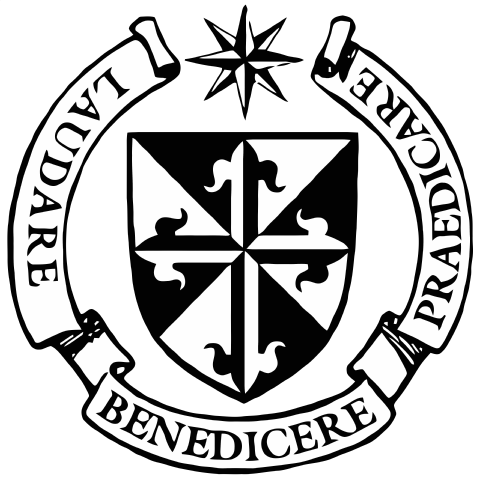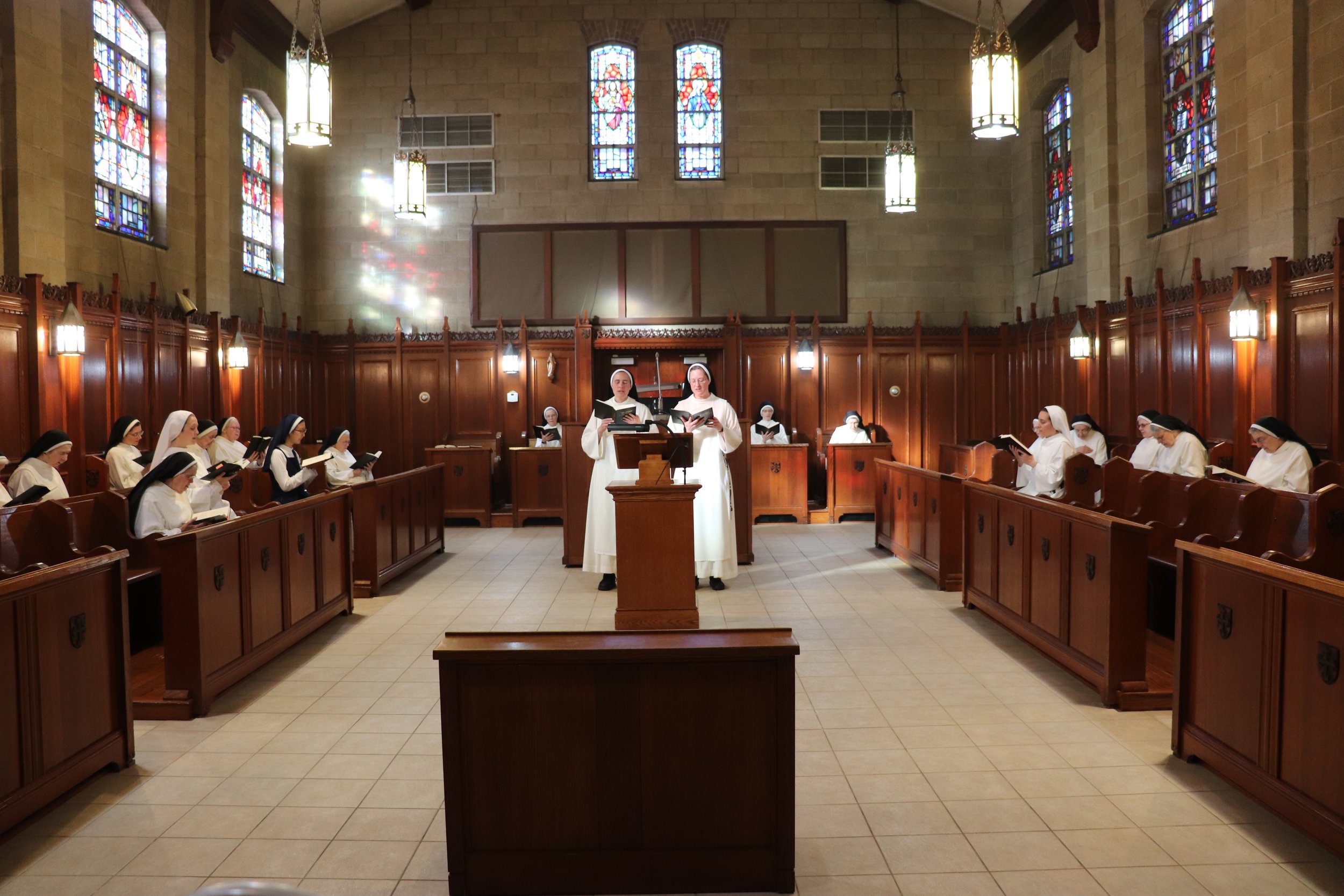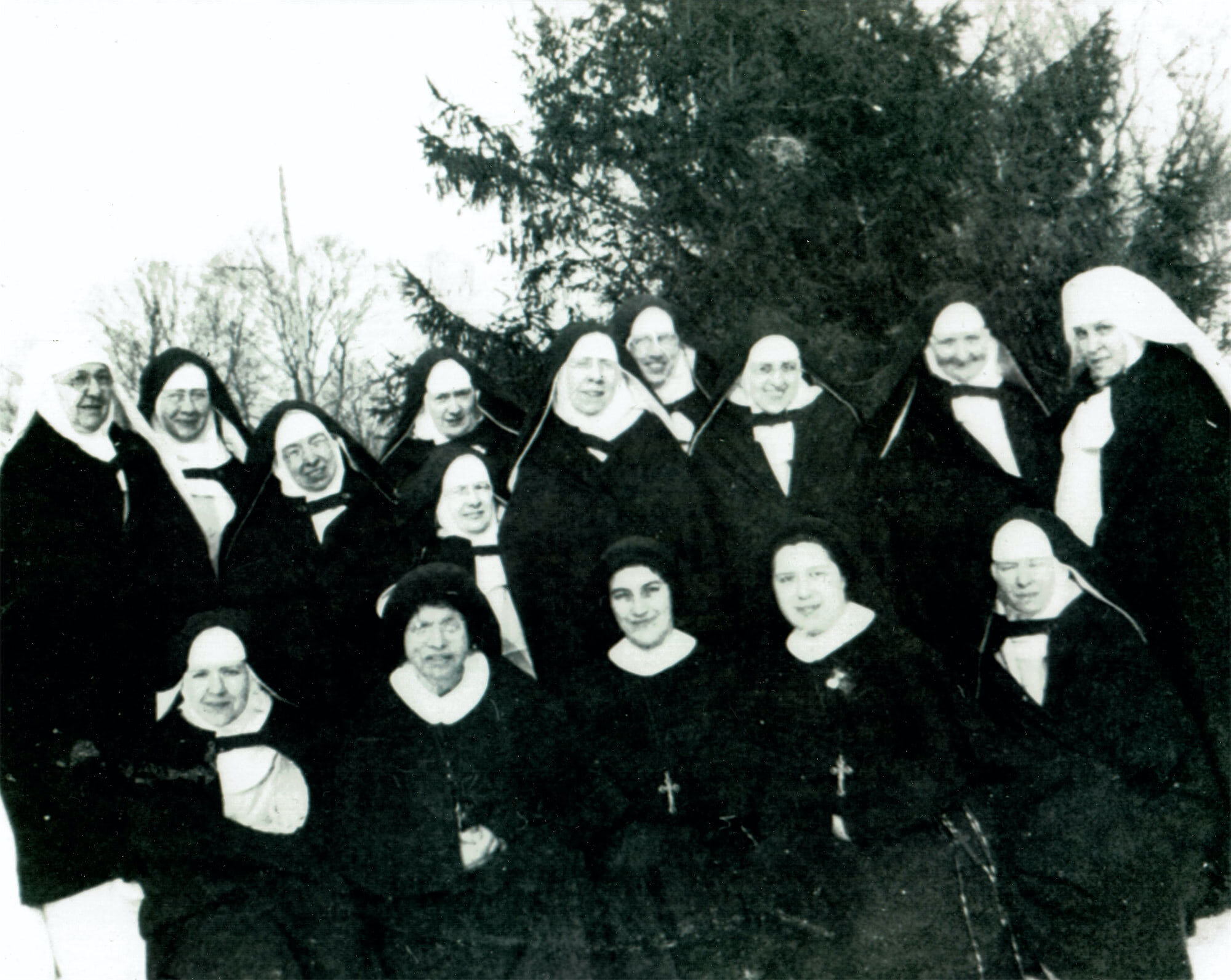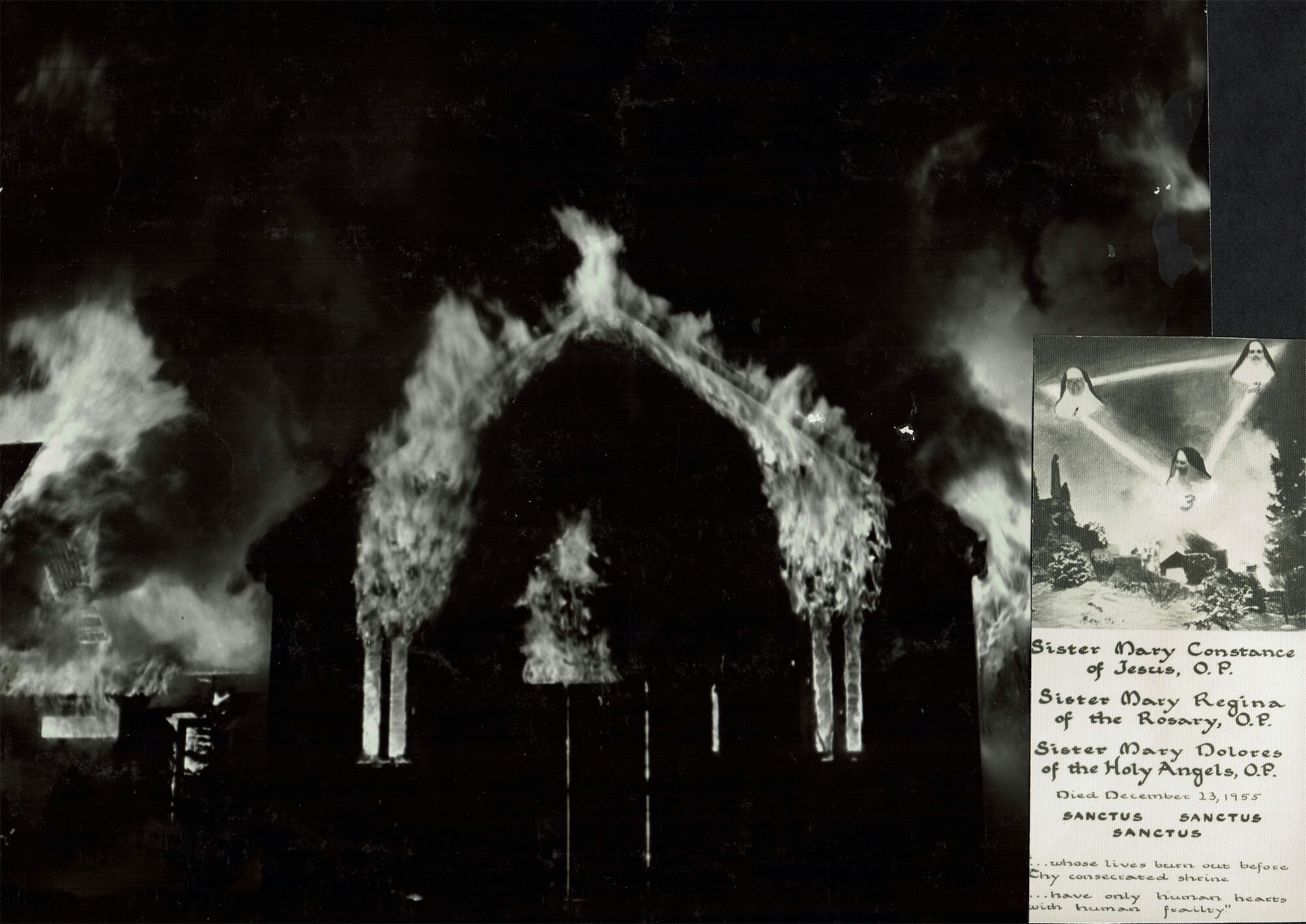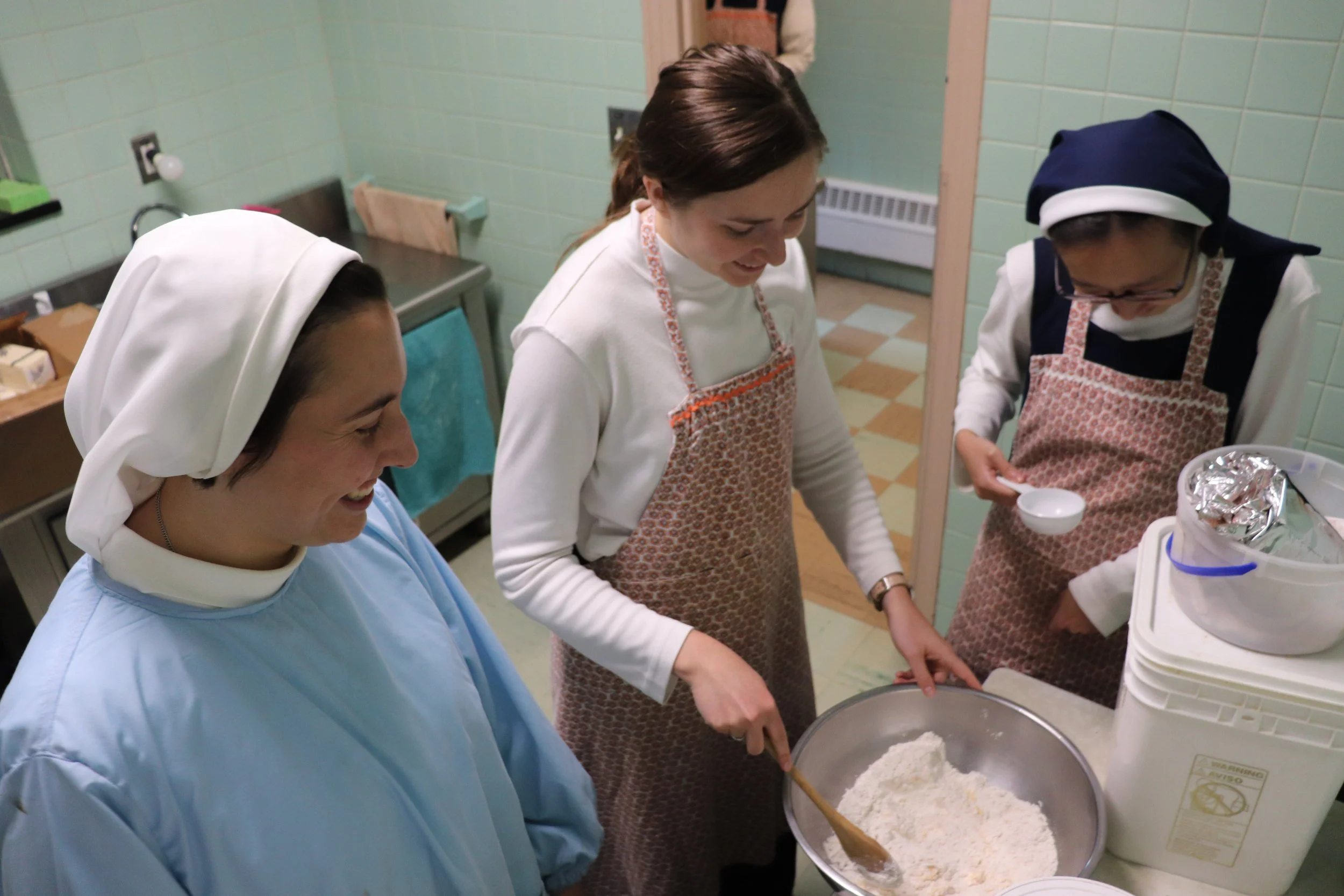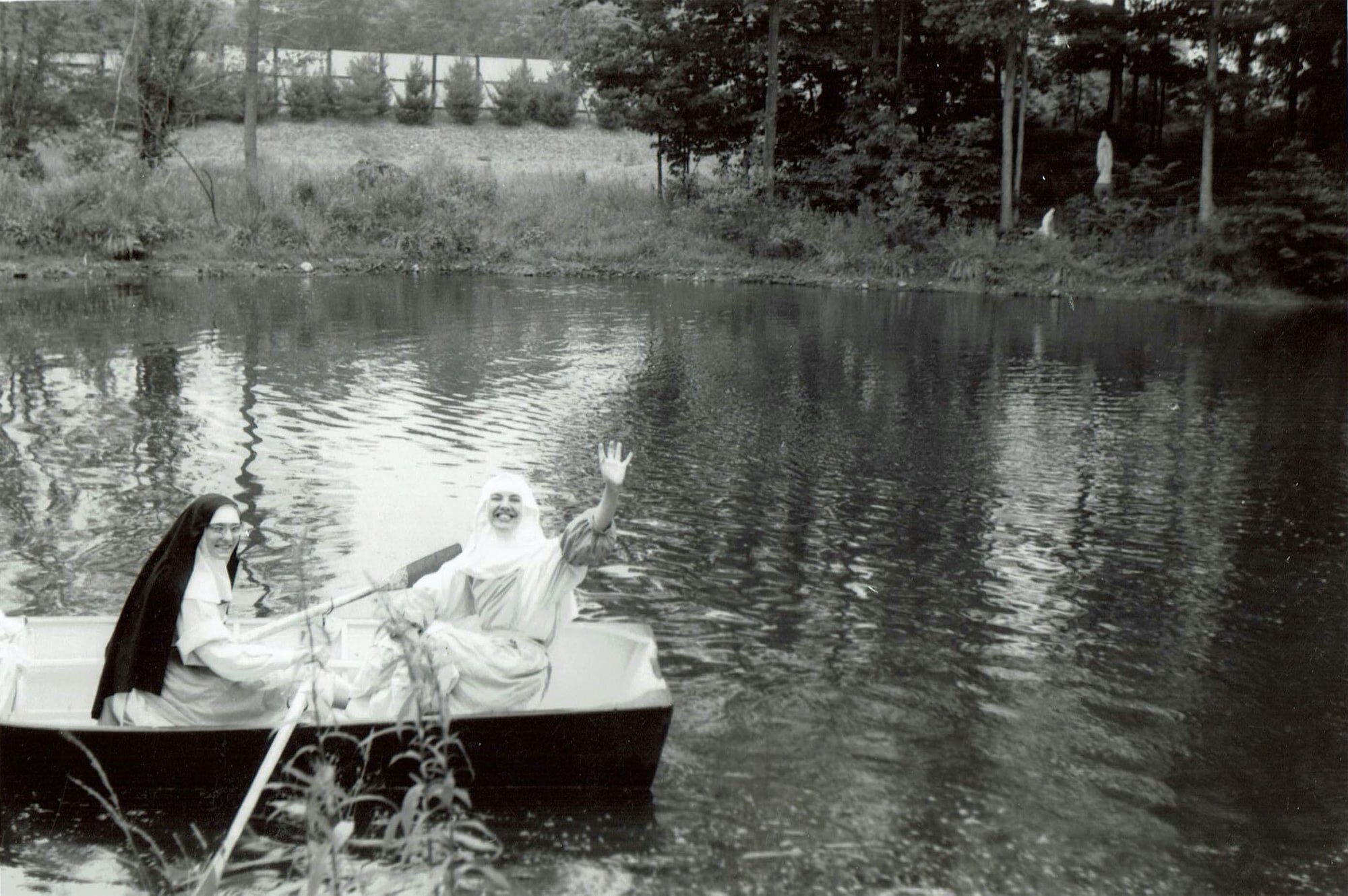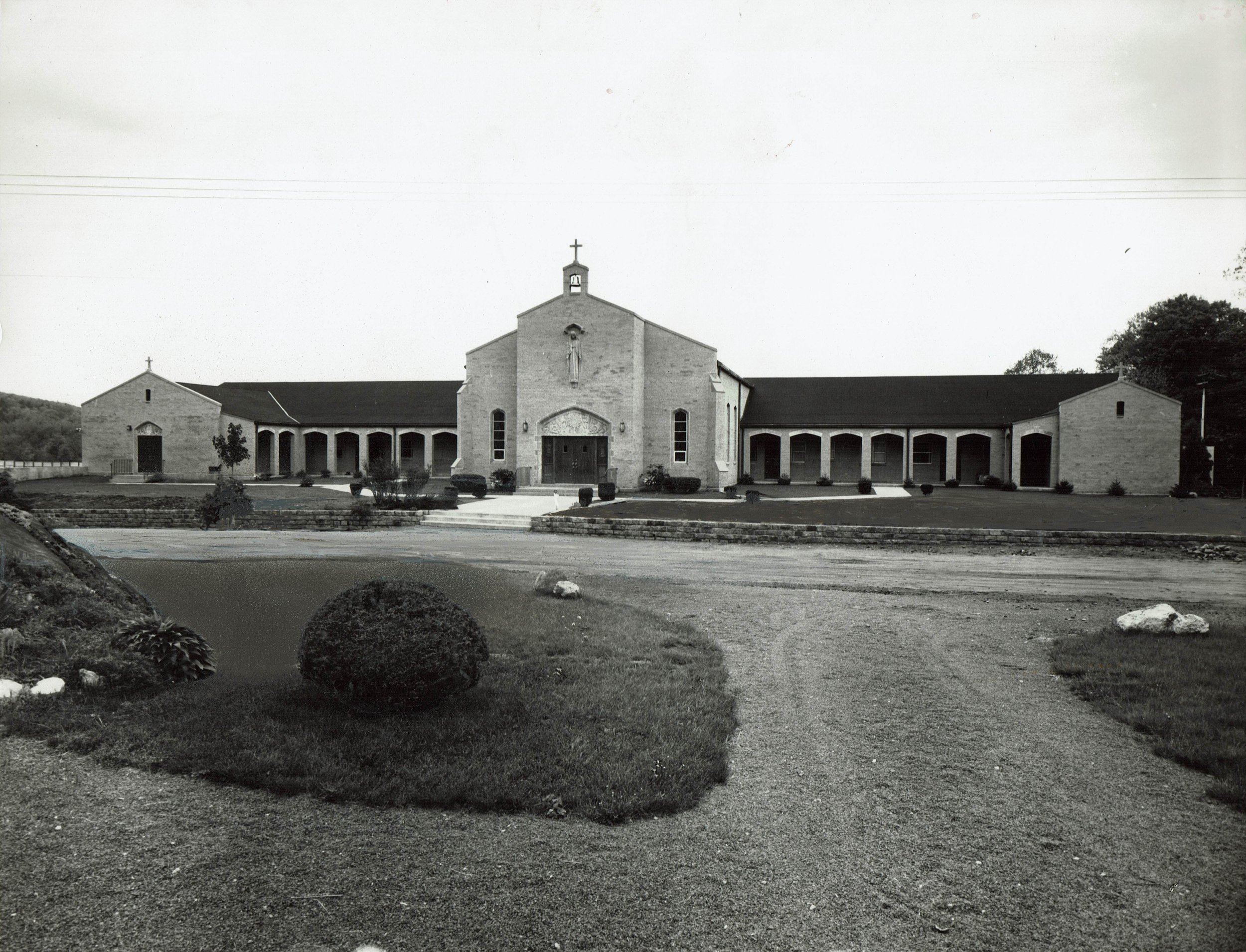
Our Community
North Guilford, CT, Founded 1947
We are a community of cloistered Dominican nuns with Solemn Vows, Papal Enclosure and devotion to the adoration of the Blessed Sacrament. Following the Rule of Saint Augustine and the Constitutions of the Nuns of the Order of Preachers, we live a hidden sacrificial life of faith, adoration, and charity at the heart of the Dominican Order, associated with the "holy preaching" of the Order by our lives of prayer and penance.
Founded in 1947 from the Dominican Monastery of Our Lady of the Rosary, Summit, New Jersey, our community now numbers 21, including two novices and one nun in simple vows. We also have a number of aspirants. Five of them will be making their residential aspirancies (living inside the cloister with us for one month) with us this summer. We ask that you keep them in your prayers.
During 2022, our community celebrated seventy-five years of Dominican monastic life. You can find pictures and stories collected for the jubilee year by clicking below.
“What we have seen and heard we proclaim now to you,
so that you too may have fellowship with us;
and this fellowship of ours
is with the Father and with his Son Jesus Christ.”
Founding & Growth
The Monastery of Our Lady of Grace in North Guilford, Connecticut was founded in 1947 by Mother Mary of Jesus Crucified (1892-1978). Mother Mary originally entered the Monastery of the Dominican Sisters of the Perpetual Rosary in Union City, New Jersey but in 1919 she helped in the founding of Our Lady of the Rosary Monastery in Summit, New Jersey and then again almost thirty years later she led the foundation of Our Lady of Grace Monastery in North Guilford, Connecticut. The foundation in North Guilford was made possible when the sisters were gifted the Samuel Chittendon property which consisted of an old farm house and two barns.
On January 21, 1947, Mother Mary and fourteen other sisters moved from Summit to North Guilford and with much labor and sacrifice turned the old house and barns into a working monastery. On February 10, 1951 the entire community made Solemn Vows, thus effecting their transition from being Sisters of the Perpetual Rosary to the more rigorous life of Second Order nuns.
Fire of 1955
After only a few years of existence, the community had expanded from the original fifteen sisters to nearly fifty sisters and plans were being made to update the building from the makeshift monastery of a farm house with adjoining barns to something more suited to monastic life. However, on December 23, 1955, the entire building burned to the ground. After Compline, as most of the sisters were retiring for the night, a fire ignited in the wall between the sacristy and the chapel. When shouts of “fire” were heard by those who had not yet gone upstairs to the dormitory, attempts were made to smother the fire, but due to the inexpensive materials of which the building was constructed the fire rapidly spread and efforts to extinguish the blaze were futile. Within minutes the chapel had filled with smoke and was unapproachable. The fire department was called and the community alerted to the danger. The floor of the dormitory was hot under the feet of the nuns as they evacuated the building. The smoke had been kept out of the upstairs portion of the building by a door to the stairwell on the first floor, but exiting the building once on the ground level required passing through thick, choking, smoke.
While most of the sisters made it through the smoke unharmed, some chose alternate routes through windows, one sister going out a second story window onto a low roof and jumping to the ground, breaking her foot in the process. Sister Mary Dolores of the Holy Angels, who had made her solemn profession just ten days before on December 13, 1955, making her the youngest of the solemnly professed sisters, hastened to help a sister with a heart condition to safely exit the building. After a head count revealed one sister missing, Sister Mary Dolores and Sister Mary Constance of Jesus received permission to re-enter the building to save the infirm Sister Mary Regina of the Rosary. Sister Mary Regina, presumably mistaking the source of the fire, had moved away from the best exit and further into the monastery. Before Sister Mary Dolores and Sister Mary Constance could help her back toward the safest exit all three were overcome with smoke.
Since they had been preparing for bed, many of the sisters were in their pajamas and slippers, meager attire for a December night. The firemen generously gave their socks and jackets to the sisters to keep warm. The surrounding community responded quickly in coming to the aid of the devastated sisters. They were given clothing, food, and shelter by the local Congregational Church as well as the Sisters of Mercy in nearby Madison, Connecticut. Near midnight, the thirty-nine surviving sisters and their chaplain, Reverend Reginald Craven, O.P., were taken by bus to New Haven where they received the hospitality of the Dominican Sisters at Albertus Magnus College.
The funeral Mass for Sister Mary Dolores, Sister Mary Constance, and Sister Mary Regina took place the following day at Albertus Magnus and arrangements were made for the deceased sisters to be buried in the Dominican section of Saint Lawrence Cemetery until they could be brought back to the cemetery in North Guilford. After a brief stay at Albertus Magnus, Archbishop O’Brien arranged for the sisters to be given the use of the Walter House, an unused building in West Haven, until the monastery in North Guilford could be rebuilt.
Amidst the rubble that once was the sacristy, two charred fragments were found. One from a prayer for priests which read, “Whose lives burn out before thy consecrated shrine. . . have only human hearts and human frailty.” The other was a shred from the Missal which read, “Sanctus, Sanctus, Sanctus.”
“Whose lives burn out before thy consecrated shrine...
...have only human hearts with human frailty.”
New Monastery
The ground-breaking ceremony for a new building took place on February 10, 1957; construction was begun of the following day – the Feast of Our Lady of Lourdes. The Fusco-Amatruda Company and their various contractors and sub-contractors worked together to hurry the building while keeping the costs down. On Easter Monday, April 7, 1958, the nuns quietly left their interim lodging in the Walter House and returned to North Guilford to a partially completed building.
The Blessed Sacrament, the center of their lives, was installed on the temporary altar in the parlor where Mass would be celebrated for the nuns until the completion of enough of the chapel would make it usable. The new Monastery of Our Lady of Grace – a rectangular building of four wings around a cloister court known as the “cloister garth” – was solemnly dedicated on the Feast of Our Lady of Grace in the 1958, the year marking the 100th anniversary of the Blessed Mother’s appearances in Lourdes, France.
Foundation in Kenya
In the years following the fire of 1955, having paid off all debts from the construction of the new monastery, the community enjoyed financial stability and an abundance of vocations. By 1962 they began to consider the possibility of a new foundation. Hearing that there would be ample interest in living a cloistered life of adoration among the religious people of Kenya, and at the request of Archbishop John J. McCarthy, C.S.Sp., the Archbishop of Nairobi, the location for the new foundation was to be Nairobi, Kenya. Over the next few years preparations were underway to bring this idea to fruition. With assistance from the Dominican Fathers at St. Thomas Aquinas Regional Seminary in Nairobi, staffed by friars of the Province of St. Joseph, Mother Mary Kathleen and another sister traveled to Africa to investigate the various possibilities for this new foundation. A 50 acre plot of land in Karen, outside Nairobi, was purchased by the Monastery of Our Lady of Grace and an architect and contractor set to work building the new monastery which was to bear the name Corpus Christi.
While the monastery itself was being prepared in Africa, in Connecticut the sisters themselves were preparing for this new venture. Volunteers were solicited from among the professed sisters and many eagerly responded. Eleven sisters were selected to join Mother Mary Kathleen as foundresses of the new monastery. On April 30, 1965, the twelve nuns embarked from New York City on the SS. Africa Neptune for their nearly month long journey to their new home.
Corpus Christi Monastery was the second Dominican monastery established in Africa and the first monastery of perpetual adoration in East Africa. As soon as possible, the monastery began admitting candidates from the local population. Eventually all the remaining foundresses returned home, and the community is currently comprised of solely African vocations. Yet, the founding monastery in Connecticut and the foundation in Kenya still enjoy the bonds and collaboration of cross-continental Dominican community.
Our Lady of Grace Today
The significant moment of the making of a foundation in Africa was followed by another significant moment with the closing of the Second Vatican Council on December 8, 1965. The following years were marked by various changes, ongoing re-formation, and revitalization in a spirit of fidelity to the Magisterium. We received new experimental Constitutions in 1971 that were made definitive in 1986.
Following the mandates of Vatican II to update and renew by returning to the sources of tradition, the community made in-depth examinations of the Dominican patrimony, especially the rich theological tradition, as well as the numerous conciliar and post-conciliar documents concerning religious life in general and the contemplative life in particular, e.g., Perfectae Caritatis and Verbi Sponsa. A result of these efforts was a retrieval of a more authentic and traditional exercise of Dominican government and a reclaiming of roots in the ancient monastic tradition. More recent years have seen liturgical changes due to the new translation of the Roman Missal in 2010 as well as a more prominent place for Gregorian chant in the liturgy, which Sacrosanctum Concilium states is its proper place. In all this we were served by our Dominican brothers who regularly visited us and shared the fruits of their own contemplation through lectures, retreat conferences and joint study projects.
In light of new Vatican legislation on women’s contemplative life, the Monastery of Our Lady of Grace became a member of the newly erected Federation of Our Lady of the Rosary in the summer of 2019. Our community was privileged to host the second Federal Assembly, during which our nuns met with representatives from our monasteries in West Springfield, Massachusetts; Marbury, Alabama; and Linden, Virginia.
On Ash Wednesday of 2022 the community received the proposed changes to our Constitutions. These changes were necessitated by the Apostolic Constitution Vultum Dei Quarerere issued by Pope Francis in 2016 and the 2018 Implementing Instruction Cor Orans. Fr. John Chrysostom Kozlowski, O.P., a Canon Lawyer, visited later in March to provide some canonical insights into the new texts. All the nuns of the Order of Preachers will be reviewing and voting on the proposed changes. Following that process a new edition of our Constitutions will be printed.
From 2021 to 2023, we experienced solidarity with our brothers and sisters throughout the world as we suffered multiple outbreaks and mourned the loss of one of our sisters from COVID-19. Fortunately, the end of the pandemic allowed us to open our newly renovated St. Catherine’s Center for the use of local Catholic groups such as the Lay Dominican Fraternities.
In 2022 and 2023 we assisted several sisters from the Monastery of Our Lady of the Rosary (formerly of Buffalo, New York and Heath, Ohio) as they joined our community. They have shared a wealth of experience, especially in traditional chant, organ artistry, and fine sewing.
In 2024 we are preparing to welcome at least two young women into our community as postulants. In an effort to strengthen our monastic observance of manual work, our candle and pottery departments have been rejuvenated, and the fruits of our labors are available in our Gift Shop, along with our delicious fudge and other handcrafted items.
